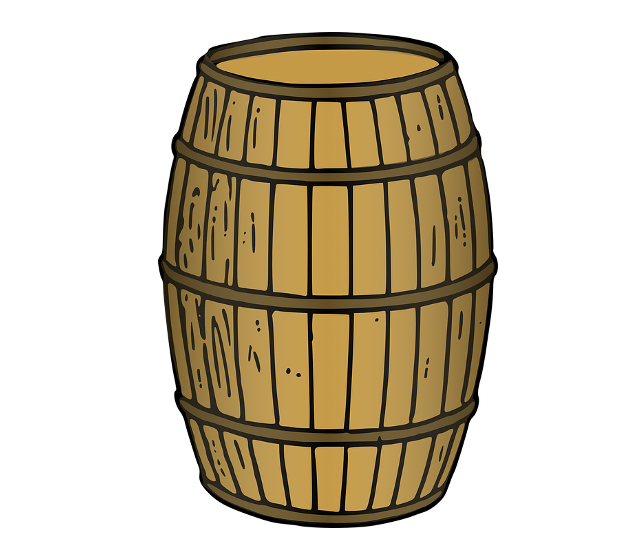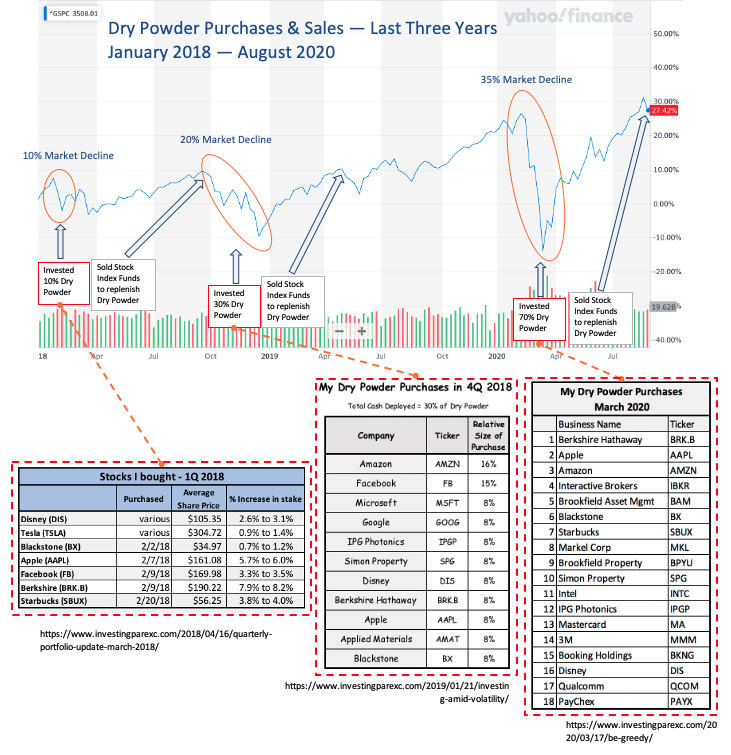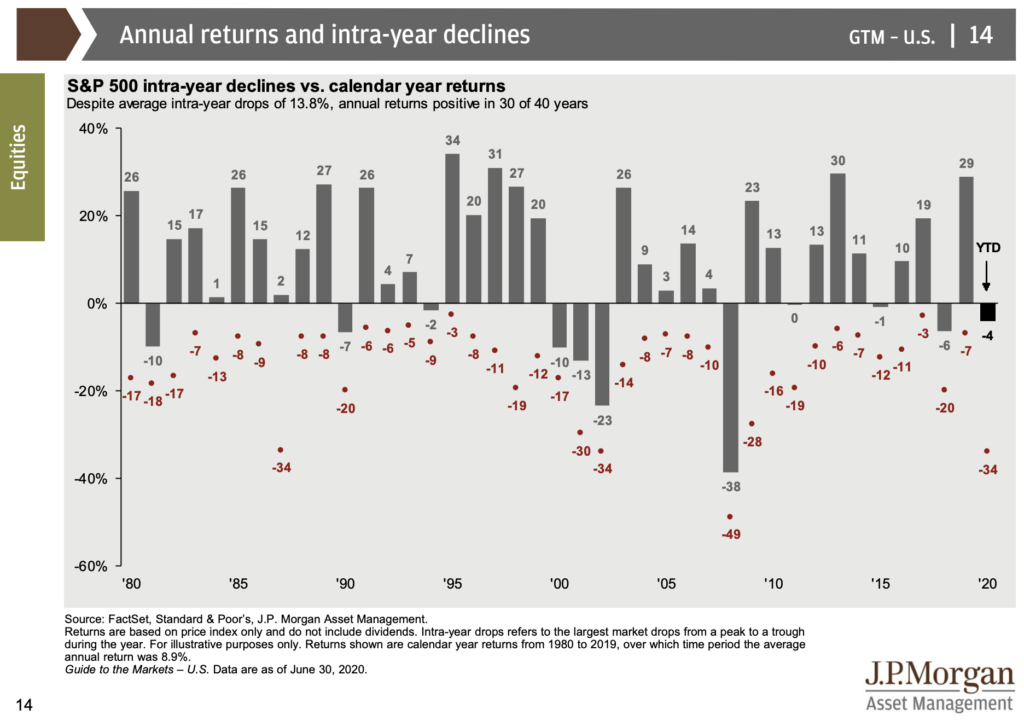
Last month, the S&P 500 Price index reached its previous high, making up for all the losses incurred in this bear market. That was my automatic trigger to sell some stocks and recoup dry powder cash. It turned out to be an unusually quick turn-around for a decline as steep as this was. In a blog post in June, I speculated that the March crash appeared to be a short-but-deep correction.
Since I started blogging about my investing here nearly three years ago, there have been three such round trips made by the S&P 500 index. Each time, I was able to deploy a portion of cash I set aside for market declines. I call this cash reserve my dry powder cash. See these blogs post for more on dry powder cash.
Two of the three market declines occurred in 2018. The first was a 10% decline in February 2018. By October, the market had recovered, only to start dropping again. That time, it dropped by almost 20% and didn’t recover until April 2019.
And then the most recent market crash was in the first quarter this year. This time, stocks went down nearly 35% by March and then began a slow climb that culminated in full recovery last month.
Lucky for us investors, none of those market declines tested our patience for too long. The market recovered from each decline within a few months. This doesn’t always happen. A bear market could last for multiple years in a row so my dry powder cash may need to stay invested for the entire duration.
To recap the last three eventful years, here’s a chart that shows my dry powder purchases and subsequent sales. Each time, the S&P 500 declined by 10% or more, I invested a portion of my dry powder cash. See my dry powder rulebook here.

What I bought? You can see from the previous chart that my stock purchases over the years were fairly consistent. Many of the businesses I bought in 1Q 2018, I bought them again in 4Q 2018, and then some more in March 2020. The market decline this year was very steep, so I was able to deploy more cash this time. I bought some new names in addition to the familiar ones that I had bought on previous two occasions. See these three blog posts I wrote when I was buying stocks in 2018 and 2020: Portfolio Update March 2018, Investing Amid Volatility 4Q Update, Be Greedy March 2020.
What I sold? As seen in the chart, each time the S&P 500 recovered to its prior peak, I sold stocks to replenish dry powder cash. But I didn’t sell any of the individual companies that I had bought. Instead, I just lightened up on my stock index fund holdings. In my 2019 portfolio update, I wrote about my plan to gradually reduce investments in passive index funds and replace them with individual company stocks. These dry powder recovery sales help me get there.
So, over the last three years, I was able to take advantage of market declines three times to scoop up new shares at good prices. Is it unusual to see three declines of greater than 10% in less than three years? No, not really. The US stock market often drops 10% (if not more) every year. See the graph below from J.P. Morgan. The S&P 500 experienced 10%+ decline in four of the last six years. More often than not, those declines turn into gains within a year.

I expect this pattern to hold, giving me more such opportunities to deploy dry powder cash in future years. Every once in a while, a market decline could turn into a protracted multi-year bear market—something many market pundits thought this year’s decline would be. It didn’t last that long this time, but some day it will. My dry powder cash can stay invested for as long as it takes the market to recover. It has staying power.
What would I buy when the market declines again? It is difficult to say at this time since I don’t know when it would happen. And what sectors (or businesses) might be impacted the most. In general though, I only buy high-quality businesses—those that could navigate through a recession and come out stronger on the other side. Companies such as those I bought in the last three years. I don’t expect all of them to turn into winners for me, but hopefully losses from my mistakes will be eclipsed by those that do well.
I keep a watch list of businesses that I like. I am also researching new businesses all the time. If I like a business but I am not yet ready to buy its shares yet, it goes to my watch list. I might not want to buy shares in that company because (a) I don’t have any cash to spend on it or (b) I consider its share price to be too high. Either way, the companies that go on my watch list become prime candidates for dry powder deployment whenever market starts declining. More on my watch list in a future post.
Shelby Cullom Davis, a highly successful American investor and philanthropist, said this famously: “You make most of your money in a bear market, you just don’t realize it at the time”. [I wrote about the Davis family two weeks ago in a post.] This year’s 35% market decline has been a testament to that old saying. Well before the market had fully recovered from its losses, the purchases I made amid the decline had propelled my portfolio to a new high. I wrote about it in July in this post: Breaking out to a new high. Let’s see how long it takes for the market to decline again from here. My BB gun is now reloaded and ready to fire.
Leave a Reply